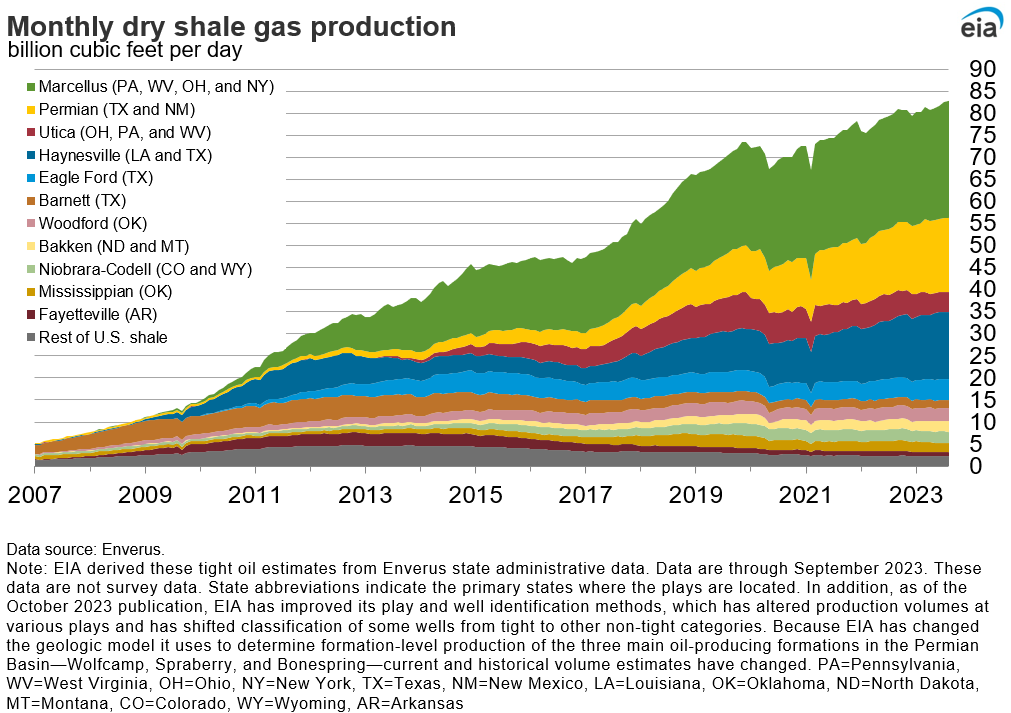In the News:
Working natural gas stocks end refill season above five-year average
Working natural gas in storage in the U.S. Lower 48 states as of October 31 totaled 3,776 billion cubic feet (Bcf), according to interpolated data from our Weekly Natural Gas Storage Report (WNGSR) released on November 16. This total represents the second-highest end-of-refill-season inventory during the past five years. Total inventory as of October 31 was 5% (178 Bcf) more than the five-year (2018–22) end-of-October average and 6.8% (239 Bcf) more than last year at this time.
Higher-than-normal inventories at the start of the refill season resulted in less natural gas net injections this refill season compared with previous years. At the start of the 2023 refill season, working gas levels totaled 1,823 Bcf—which is the second-highest level since 2017 and 19% above the five-year average. We estimate that net injections totaled 1,953 Bcf during the 2023 refill season (April 1–October 31), 5% (109 Bcf) less than the five-year average and 9% (203 Bcf) less than last year’s refill season.
Net injections of natural gas into storage decreased from year-ago levels despite increases in U.S. dry natural gas production. U.S. dry natural gas production increased 3% to average 103.8 billion cubic feet per day (Bcf/d) during the 2023 refill season compared with 100.4 Bcf/d during the 2022 refill season, according to data from our Short-Term Energy Outlook (STEO). U.S. natural gas consumption during the 2023 refill season increased by 3% (2.3 Bcf/d) from year-ago levels with electric power sector consumption rising 6% (2.1 Bcf/d), residential and commercial sectors combined consumption falling 2% (0.3 Bcf/d), and industrial demand up nearly 1% (0.2 Bcf/d). Natural gas exports also increased; liquefied natural gas (LNG) exports rose 15% (1.5 Bcf/d), and pipeline exports increased 8% (0.7 Bcf/d).
During most of the early weeks of the refill season, net injections of natural gas into storage exceeded the five-year average, as the storage surplus grew from 298 Bcf on March 31 and peaked at 370 Bcf during the week ending June 30. Following June 30, net injections of natural gas into storage fell short of the five-year average during the next 11 consecutive weeks. The surplus to the five-year average fell as low as 163 Bcf during the week ending October 6, before increasing again during the final weeks of the refill season, as cooler temperatures softened air conditioning demand and, in turn, consumption of natural gas for electric power.
Although the end of the natural gas storage injection season is traditionally defined as October 31, net injections often occur in November.
Market Highlights:
(For the week ending Wednesday, November 15, 2023)Prices
- Henry Hub spot price: The Henry Hub spot price rose 66 cents from $2.21 per million British thermal units (MMBtu) last Wednesday to $2.87/MMBtu yesterday.
- Henry Hub futures price: The price of the December 2023 NYMEX contract increased 0.3 cents, from $3.106/MMBtu last Wednesday to $3.109/MMBtu yesterday. The price of the 12-month strip averaging December 2023 through November 2024 futures contracts declined 2.2 cents to $3.284/MMBtu.
- Select regional spot prices: Natural gas spot prices rose at most locations this report week (Wednesday, November 8 to Wednesday, November 15). Price changes ranged from an increase of 35 cents/MMBtu at the Chicago Citygate to an increase of $3.10/MMBtu at Malin, Oregon.
- Prices in the Northeast rose with higher natural gas consumption. At the Algonquin Citygate, which serves Boston-Area consumers, the price rose 57 cents from $1.95/MMBtu last Wednesday to $2.52/MMBtu yesterday. In the Boston Area, temperatures this report week averaged 41°F, 8°F lower than the previous report week and 5°F below normal, leading to 167 heating degree days (HDDs) for the week, 33 more HDDs than normal. Total natural gas consumption in New England rose 25% this week, as demand for space heating also raised industrial and electric power sector consumption. At the Transco Zone 6 pricing hub in New York, prices rose 65 cents from $1.60/MMBtu last Wednesday to $2.25/MMBtu yesterday. Temperatures in the New York-Central Park Area followed a similar pattern as Boston temperatures. The colder temperatures led to a 24%, or 2.1 billion cubic feet per day (Bcf/d), increase in residential and commercial sector consumption in the Northeast compared with the previous week, according to data from S&P Global Commodity Insights.
- Natural gas prices rose across the West. In the Pacific Northwest, prices rose as cooler weather increased residential and commercial sector consumption for space heating. In the Seattle-Tacoma Airport Area, temperatures averaged 46°F this week, down 6°F from the previous week, leading to 133 HDDs, 45 more HDDs than the previous report week. Residential and commercial sector consumption in the Pacific Northwest rose 38% (0.3 Bcf/d) this week, according to S&P Global Commodity Insights, because of increased space heating demand. The price at Sumas on the Canada-Washington border, the main pricing point for natural gas delivered into the Pacific Northwest, rose $3.08 from $2.85/MMBtu last Wednesday to $5.93/MMBtu yesterday.
- Prices in California rose as colder weather increased residential and commercial sector consumption. The price at Malin, Oregon, the northern delivery point into the PG&E service territory, rose $3.10 from $2.90/MMBtu last Wednesday to $6.00/MMBtu yesterday. This trend followed increases in upstream markets, including in the Pacific Northwest (see above) and at the Opal Hub in southwest Wyoming, where the price rose $3.42 from $2.90/MMBtu last Wednesday to $6.32/MMBtu yesterday. The Ruby Pipeline originating at the Opal Hub delivers natural gas into the PG&E market at Malin. The price at PG&E Citygate in Northern California rose $2.52 from $3.86/MMBtu last Wednesday to $6.38/MMBtu yesterday. In the San Jose Area, temperatures averaged 61°F this week, down 3°F from the previous week, leading to 24 HDDs, 13 more than the previous report week. In California, residential and commercial sector consumption increased 25% (0.4 Bcf/d), and natural gas consumption for power generation rose 13% (0.2 Bcf/d). The price at SoCal Citygate in Southern California remained elevated relative to other major hubs, but price changes were muted, rising $0.50 from $6.49/MMBtu last Wednesday to $6.99/MMBtu yesterday. Prices at delivery points into the Southern California Gas (SoCalGas) market rose sharply. The Price at Ehrenberg on the California/Arizona border rose $3.81 from $1.86/MMBtu last Wednesday to $5.67/MMBtu yesterday. Similar price increases were reported at other delivery points into SoCalGas territory.
- The price at the Waha Hub in West Texas, which is located near Permian Basin production activities, rose $1.39 this report week, from $0.96/MMBtu last Wednesday to $2.35/MMBtu yesterday. The Waha Hub traded 52 cents below the Henry Hub price yesterday, compared with last Wednesday when it traded $1.25 below the Henry Hub price.
- International futures prices: International natural gas futures price changes were mixed this report week. According to Bloomberg Finance, L.P., weekly average front-month futures prices for liquefied natural gas (LNG) cargoes in East Asia decreased 29 cents to a weekly average of $17.17/MMBtu. Natural gas futures for delivery at the Title Transfer Facility (TTF) in the Netherlands increased 33 cents to a weekly average of $14.97/MMBtu. In the same week last year (week ending November 16, 2022), the prices were $27.06/MMBtu in East Asia and $34.10/MMBtu at TTF.
- Natural gas plant liquids (NGPL) prices: The natural gas plant liquids composite price at Mont Belvieu, Texas, fell by 24 cents/MMBtu, averaging $6.70/MMBtu for the week ending November 15. Weekly average ethane prices fell 12%, while weekly average natural gas prices at the Houston Ship Channel rose 16% week over week. The ethane premium to natural gas fell 42%. Ethylene spot prices fell 6%, and the ethylene premium to ethane fell 1%. The average weekly propane price fell 1%, and the Brent crude oil price fell 3%. The propane discount relative to crude oil fell 5%. The price of natural gasoline fell 1%, the normal butane price rose 1%, and the isobutane price fell 4%.
Daily spot prices by region are available on the EIA website.
Supply and Demand
- Supply: According to data from S&P Global Commodity Insights, the average total supply of natural gas rose by 0.9% (1.0 Bcf/d) compared with the previous report week. Dry natural gas production grew by 0.6% (0.6 Bcf/d) to an average of 105.3 Bcf/d, topping the record high set last week. Average net imports from Canada increased by 6.5% (0.3 Bcf/d) from last week.
- Demand: Total U.S. consumption of natural gas rose by 7.9% (6.1 Bcf/d) compared with the previous report week, according to data from S&P Global Commodity Insights. Natural gas consumed for power generation rose 3.4% (1.1 Bcf/d). Industrial sector consumption increased by 1.4% (0.3 Bcf/d) and residential and commercial sector consumption climbed 21.5% (4.7 Bcf/d), as below-normal temperatures boosted space heating demand in population centers in the Northeast and West Coast. Natural gas exports to Mexico were essentially unchanged on the week. Natural gas deliveries to U.S. LNG export facilities (LNG pipeline receipts) averaged 14.2 Bcf/d, or 0.3 Bcf/d higher than last week.
Liquefied Natural Gas (LNG)
- Pipeline receipts: Average natural gas deliveries to U.S. LNG export terminals rose 2.2% (0.3 Bcf/d) week over week, averaging 14.2 Bcf/d, according to data from S&P Global Commodity Insights. Natural gas deliveries to terminals in South Louisiana rose by 5.8% (0.5 Bcf/d) to 9.1 Bcf/d. Natural gas deliveries to terminals in South Texas fell by 2.8% (0.1 Bcf/d) to 4.0 Bcf/d. Natural gas deliveries to terminals outside the Gulf Coast fell by 6.5% (0.1 Bcf/d) to 1.1 Bcf/d.
- Vessels departing U.S. ports: Twenty-seven LNG vessels (10 from Sabine Pass; 5 each from Cameron and Corpus Christi; 3 each from Calcasieu Pass and Freeport; and 1 from Cove Point) with a combined LNG-carrying capacity of 100 Bcf departed the United States between November 9 and November 15, according to shipping data provided by Bloomberg Finance, L.P.
Rig Count
- According to Baker Hughes, for the week ending Tuesday, November 7, the natural gas rig count remained unchanged at 118 rigs. The Haynesville and Marcellus each dropped one rig, while the Utica added one rig, and one rig was added among unidentified producing regions. The number of oil-directed rigs fell by 2 to 494 rigs, as 2 rigs were dropped among unidentified producing regions. The total rig count decreased by 2 rigs, and it now stands at 616 rigs.
Storage
- For the week ending November 10, net injections into storage totaled 60 Bcf compared with the five-year (2018–2022) average net injections of 20 Bcf and last year's net injections of 66 Bcf during the same week. Working natural gas stocks totaled 3,833 Bcf, which is 203 Bcf (6%) more than the five-year average and 198 Bcf (5%) more than last year at this time.
- According to The Desk survey of natural gas analysts, for the week ending November 10, estimates of the weekly net change to working natural gas stocks ranged from net injections of 24 Bcf to 68 Bcf, with a median estimate of 44 Bcf.
- For the week ending November 3, net withdrawals from storage totaled 6 Bcf compared with the five-year (2018–2022) average net injections of 36 Bcf and last year's net injections of 83 Bcf during the same week. Working natural gas stocks totaled 3,773 Bcf, which was 163 Bcf (5%) more than the five-year average and 204 Bcf (6%) more than last year at that time.
- According to The Desk survey of natural gas analysts, for the week ending November 3, estimates of the weekly net change to working natural gas stocks ranged from net withdrawals of 18 Bcf to net injections of 5 Bcf, with a median estimate of net withdrawals of 6 Bcf.
See also:
Top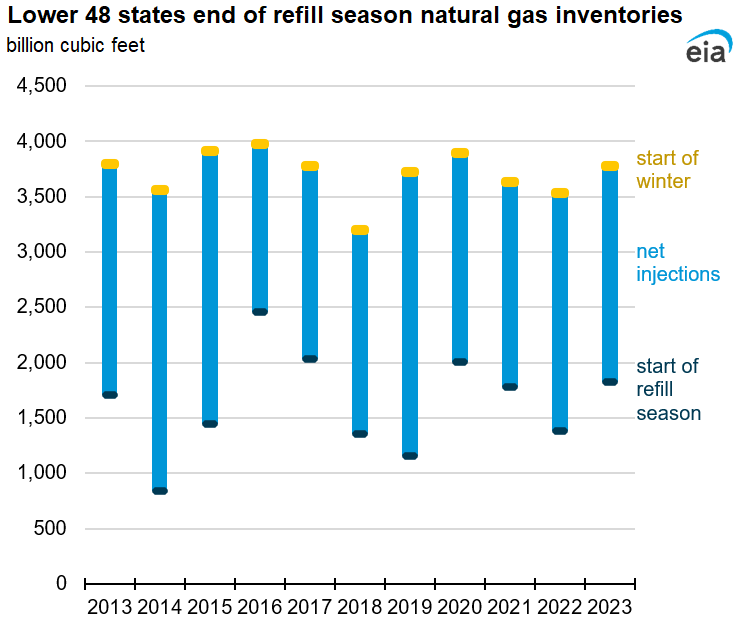 Data source: U.S. Energy Information Administration, Natural Gas Monthly and Weekly Natural Gas Storage Report
Data source: U.S. Energy Information Administration, Natural Gas Monthly and Weekly Natural Gas Storage Report
Note: Natural gas refill season is defined as April 1–October 31. The data point for October 31, 2023, is an interpolated value, based on the Weekly Natural Gas Storage Report.
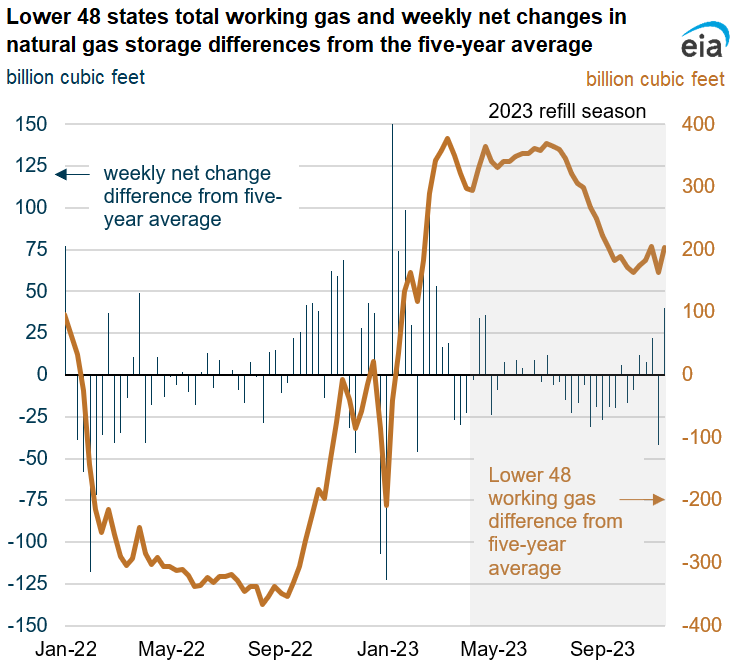 Data source: U.S. Energy Information, Weekly Natural Gas Storage Report
Data source: U.S. Energy Information, Weekly Natural Gas Storage Report Note: Natural gas refill season is defined as April 1–October 31.
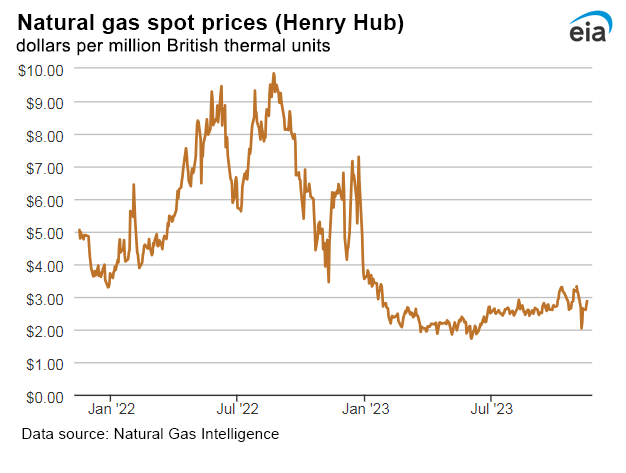
| Spot Prices ($/MMBtu) | Thu, 09-Nov |
Fri, 10-Nov |
Mon, 13-Nov |
Tue, 14-Nov |
Wed, 15-Nov |
|---|---|---|---|---|---|
| Henry Hub | 2.65 | Holiday | 2.61 | 2.76 | 2.87 |
| New York | 1.93 | Holiday | 2.48 | 2.37 | 2.25 |
| Chicago | 2.18 | Holiday | 2.43 | 2.66 | 2.55 |
| Cal. Comp. Avg.* | 3.11 | Holiday | 4.66 | 5.69 | 6.11 |
| Futures ($/MMBtu) | |||||
| December Contract | 3.041 | 3.033 | 3.197 | 3.106 | 3.109 |
| January Contract | 3.333 | 3.284 | 3.400 | 3.316 | 3.362 |
| *Avg. of NGI's reported prices for: Malin, PG&E Citygate, and Southern California Border Avg. | |||||
| Data source: NGI's Daily Gas Price Index | |||||
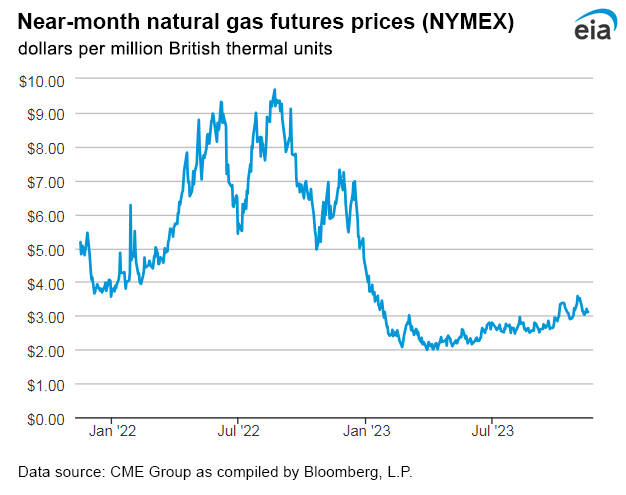
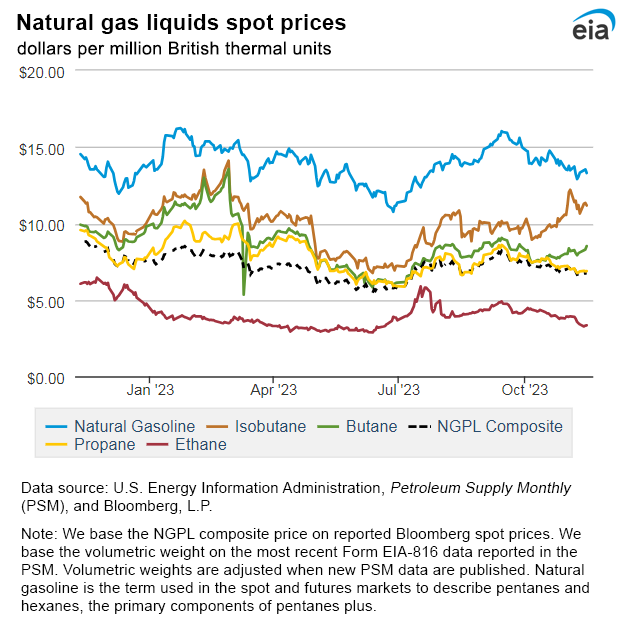
| U.S. natural gas supply - Gas Week: (11/9/23 - 11/15/23) | |||
|---|---|---|---|
Average daily values (billion cubic feet) |
|||
this week |
last week |
last year |
|
| Marketed production | 119.2 |
118.6 |
114.4 |
| Dry production | 105.3 |
104.7 |
101.5 |
| Net Canada imports | 5.7 |
5.3 |
5.2 |
| LNG pipeline deliveries | 0.1 |
0.1 |
0.1 |
| Total supply | 111.1 |
110.1 |
106.8 |
|
Data source: S&P Global Commodity Insights | |||
| U.S. natural gas consumption - Gas Week: (11/9/23 - 11/15/23) | |||
|---|---|---|---|
Average daily values (billion cubic feet) |
|||
this week |
last week |
last year |
|
| U.S. consumption | 83.2 |
77.1 |
81.7 |
| Power | 32.6 |
31.6 |
30.7 |
| Industrial | 23.9 |
23.6 |
24.0 |
| Residential/commercial | 26.7 |
21.9 |
27.0 |
| Mexico exports | 6.5 |
6.4 |
5.6 |
| Pipeline fuel use/losses | 7.4 |
7.2 |
7.2 |
| LNG pipeline receipts | 14.2 |
13.9 |
11.7 |
| Total demand | 111.3 |
104.6 |
106.2 |
|
Data source: S&P Global Commodity Insights | |||
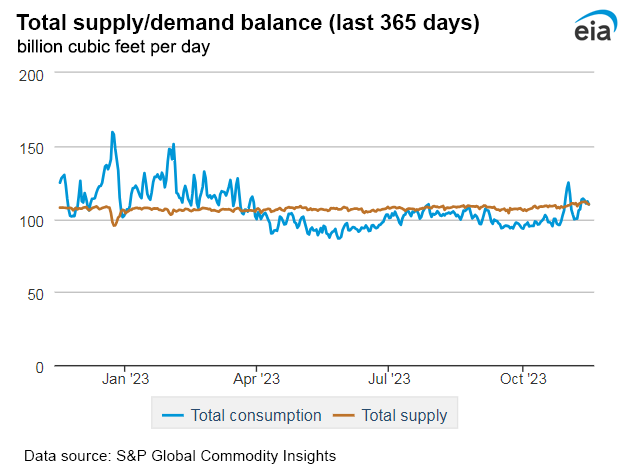
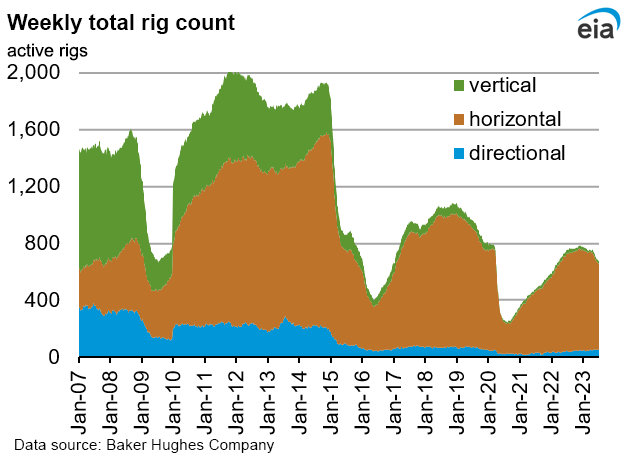
| Rigs | |||
|---|---|---|---|
Tue, November 07, 2023 |
Change from |
||
|
last week
|
last year
|
||
| Oil rigs |
494
|
-0.4%
|
-20.6%
|
| Natural gas rigs |
118
|
0.0%
|
-23.9%
|
| Note: Excludes any miscellaneous rigs | |||
| Rig numbers by type | |||
|---|---|---|---|
Tue, November 07, 2023 |
Change from |
||
|
last week
|
last year
|
||
| Vertical |
12
|
-20.0%
|
-45.5%
|
| Horizontal |
551
|
0.4%
|
-22.5%
|
| Directional |
53
|
-1.9%
|
15.2%
|
| Data source: Baker Hughes Company | |||
| Working gas in underground storage | ||||
|---|---|---|---|---|
Stocks billion cubic feet (Bcf) |
||||
| Region | 2023-11-10 |
2023-11-03 |
change |
|
| East | 931 |
924 |
7 |
|
| Midwest | 1,116 |
1,105 |
11 |
|
| Mountain | 256 |
253 |
3 |
|
| Pacific | 292 |
284 |
8 |
|
| South Central | 1,238 |
1,206 |
32 |
|
| Total | 3,833 |
3,773 |
60 |
|
|
Data source: U.S. Energy Information Administration Form EIA-912, Weekly Underground Natural Gas Storage Report
Note: Totals may not equal sum of components because of independent rounding. | ||||
| Working gas in underground storage | |||||
|---|---|---|---|---|---|
Historical comparisons |
|||||
Year ago (11/10/22) |
5-year average (2018-2022) |
||||
| Region | Stocks (Bcf) |
% change |
Stocks (Bcf) |
% change |
|
| East | 880 |
5.8 |
897 |
3.8 |
|
| Midwest | 1,082 |
3.1 |
1,075 |
3.8 |
|
| Mountain | 208 |
23.1 |
210 |
21.9 |
|
| Pacific | 242 |
20.7 |
276 |
5.8 |
|
| South Central | 1,223 |
1.2 |
1,173 |
5.5 |
|
| Total | 3,635 |
5.4 |
3,630 |
5.6 |
|
| Data source: U.S. Energy Information Administration Form EIA-912, Weekly Underground Natural Gas Storage Report
Note: Totals may not equal sum of components because of independent rounding. |
|||||
| Temperature – heating & cooling degree days (week ending Nov 09) | ||||||||
|---|---|---|---|---|---|---|---|---|
HDDs |
CDDs |
|||||||
| Region | Current total |
Deviation from normal |
Deviation from last year |
Current total |
Deviation from normal |
Deviation from last year |
||
| New England | 143 |
1 |
69 |
0 |
0 |
-1 |
||
| Middle Atlantic | 123 |
-11 |
59 |
0 |
0 |
-1 |
||
| E N Central | 119 |
-31 |
39 |
0 |
0 |
0 |
||
| W N Central | 124 |
-39 |
2 |
0 |
0 |
0 |
||
| South Atlantic | 69 |
-16 |
40 |
12 |
-3 |
-18 |
||
| E S Central | 55 |
-32 |
33 |
2 |
0 |
-8 |
||
| W S Central | 26 |
-26 |
9 |
25 |
15 |
-7 |
||
| Mountain | 113 |
-35 |
-50 |
6 |
4 |
6 |
||
| Pacific | 45 |
-24 |
-68 |
0 |
-1 |
0 |
||
| United States | 90 |
-25 |
11 |
6 |
1 |
-4 |
||
|
Data source: National Oceanic and Atmospheric Administration Note: HDDs=heating degree days; CDDs=cooling degree days | ||||||||
Average temperature (°F)
7-day mean ending Nov 09, 2023
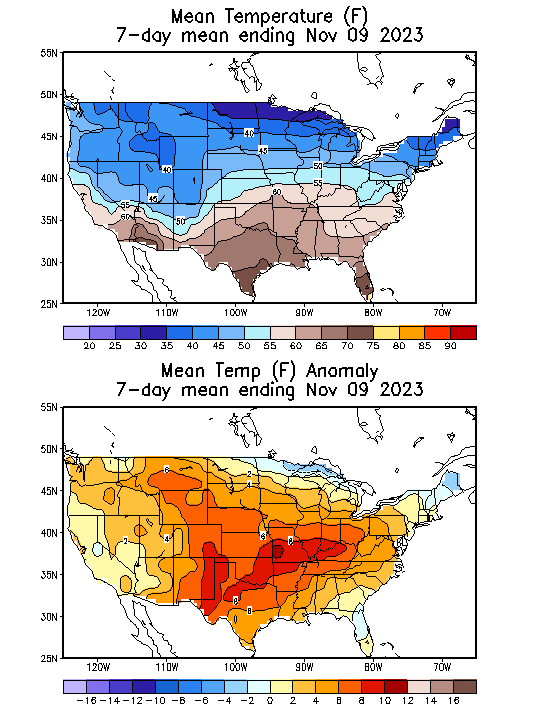
Data source: National Oceanic and Atmospheric Administration
Deviation between average and normal temperature (°F)
7-day mean ending Nov 09, 2023

Data source: National Oceanic and Atmospheric Administration

